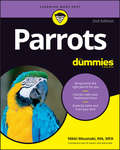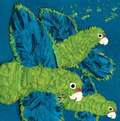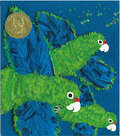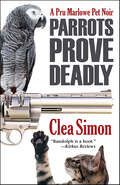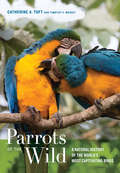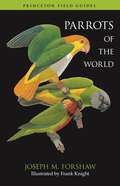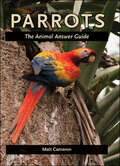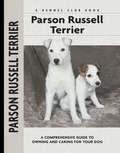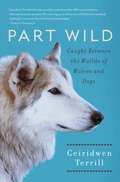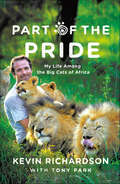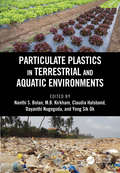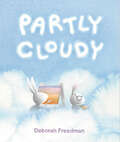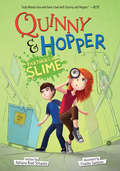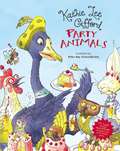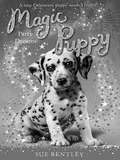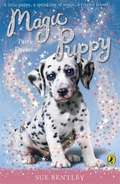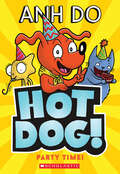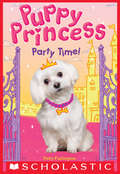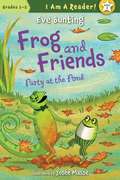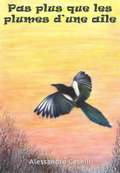- Table View
- List View
Parrots (Nature's Children)
by Merebeth SwitzerIn this book you will learn about the parrot family including some of its more fascinating members including lovebirds, macaws, and parrots that don't fly.
Parrots For Dummies
by Nikki MoustakiParrots make a wonderful alternative to the traditional pet. They're as loving, intelligent, companionable, and entertaining as a cat or a dog but they surpass them by far in many other ways. They don't require walks around the block, they're perfect for apartment living, most have long life spans, and they're full of personality. Besides, when was the last time you saw a vibrant blue cat or had a conversation with a talking dog? Whether you are just thinking about buying a parrot or you've had parrots for years, Parrots for Dummies is full of helpful information about how to be the best parrot guardian you can be. Parrots for Dummies is packed full of useful tips, hints, reminders, and warnings about everything related to parrots and their care, including: Picking a parrot Bringing a new parrot home Parrot behavior made simple Taming and training your bird Travel tips Author Nikki Moustaki, avian care and behavior consultant and author of Parakeets for Dummies, gives you all of her experienced advice about owning, caring for, and loving parrots. She draws on her professional knowledge as well as her personal familiarity with the bird to show you how to make the most of your parrot-guardian relationship. She includes information on: Purchasing and adopting a parrot Proper housing and food Parrot illnesses and diseases Correcting behavioral problems Living in a multiple parrot household Breeding and showing parrots In addition to all the help and guidance, Parrots for Dummies comes with a full-color insert with pictures of over 25 different kinds of parrots to help you choose a new pet that catches your eye or find your existing pet's nearest relation. So whether you're buying your first parrot or looking for some advice about an old friend, Parrots for Dummies has something for you.
Parrots For Dummies
by Nikki MoustakiRepeat after me: Parrots aren’t just for pirates! While parrots have a historical reputation for being a pirate's best friend, in the modern-day U.S.—where birds are the nation’s third most popular household pet-thousands of landlubbers are in on the act! And that’s not surprising—parrots are as affectionate, friendly, and fun to be with as a dog or cat. They are also relatively low-maintenance, with no rude 5 a.m. awakenings with demands for food or punishing walks. Renowned avian care and behavior consultant Nikki Moustaki is your friendly guide to the colorful world of this intelligent and chatty pet. In this book, you'll be introduced to the vibrant diversity of the parrot world, which covers a wide variety of Psittacidae family members, including macaws, cockatiels, and parakeets. You'll also learn the best ways to choose, care for, and love your resplendently feathered companion. Pick your perfect parrot Devour the latest on nutrition Tame and train Make the perfect home Whether you're just setting out in the parrot world or are a seasoned voyager on the parrot-y seas, this 2nd edition of Parrots For Dummies has something for you and your pet—and will repay the hard-won pirate gold you spent on it a thousand times over!
Parrots Over Puerto Rico
by Susan L. Roth Cindy TrumboreA picture book telling the intertwined histories of the Puerto Rican parrot and the island of Puerto Rico, culminating with current efforts to save the parrots from extinction. Puerto Rican parrots, once abundant, came perilously close to extinction in the 1960s due to centuries of foreign exploration and occupation, development, and habitat destruction. In this compelling book, Roth and Trumbore recount the efforts of the scientists of the Puerto Rican Parrot Recovery Program to save the parrots and ensure their future. Woven into the parrots' story is a brief history of Puerto Rico itself, from before the first human settlers to the present day.<P><P> <b>Winner of the Sibert Medal</b> <P><b>Winner of the 2018 Riverby Award</b>
Parrots Over Puerto Rico
by Susan L. Roth Cindy TrumboreRobert F. Sibert Informational Book Award - American Library Association (ALA)A nonfiction picture book about the history of Puerto Rico and the Puerto Rican parrot, which was brought back from the brink of extinction. Also available in Spanish.Above the treetops of Puerto Rico flies a flock of parrots as green as their island home... These are Puerto Rican parrots. They lived on this island for millions of years, and then they nearly vanished from the earth forever.Puerto Rican parrots, once abundant, came perilously close to extinction in the 1960s due to centuries of foreign exploration and occupation, development, and habitat destruction. In this compelling book, Roth and Trumbore recount the efforts of the scientists of the Puerto Rican Parrot Recovery Program to save the parrots and ensure their future. Woven into the parrots' story is a brief history of Puerto Rico itself, from before the first human settlers to the present day.With striking collage illustrations, a unique format, and engaging storytelling, Parrots Over Puerto Rico invites readers to witness the amazing recovery efforts that have enabled Puerto Rican parrots to fly over their island once again.
Parrots Prove Deadly (Pru Marlowe Pet Noir #3)
by Clea SimonParrots will repeat anything. They don't talk sense. Or do they?When Pru Marlowe is called in to retrain a foul-mouthed African gray after its owner's death, the bad-girl animal psychic can't help hearing the bird's words as a replay of a murder scene. But the doctor on call scoffs at the idea, and the heirs just want their late mother's pet to quit cursing.With the only other possible witnesses being an evasive aide, the blind neighbor, and a single-minded service dog, Pru is stuck with what may be a feather-brained theory. Even her crotchety tabby Wallis doesn't buy it, although she's more than willing to "interrogate" the big bird, as Pru deals with drugs, jealousy, and a potential rabies outbreak....
Parrots of the Wild
by Timothy F. Wright Catherine A. ToftParrots of the Wild explores recent scientific discoveries and what they reveal about the lives of wild parrots, which are among the most intelligent and rarest of birds. Catherine A. Toft and Tim Wright discuss the evolutionary history of parrots and how this history affects perceptual and cognitive abilities, diet and foraging patterns, and mating and social behavior. The authors also discuss conservation status and the various ways different populations are adapting to a world that is rapidly changing. The book focuses on general patterns across the 350-odd species of parrots, as well as what can be learned from interesting exceptions to these generalities. A synthetic account of the diversity and ecology of wild parrots, this book distills knowledge from the authors' own research and from their review of more than 2,400 published scientific studies. The book is enhanced by an array of illustrations, including nearly ninety color photos of wild parrots represented in their natural habitats. Parrots of the Wild melds scientific exploration with features directed at the parrot enthusiast to inform and delight a broad audience.
Parrots of the World (Princeton Field Guides #70)
by Joseph M. ForshawThe world’s parrots in one convenient field guideFrom the macaws of South America to the cockatoos of Australia, parrots are among the most beautiful and exotic birds in the world—and among the most endangered. This stunningly illustrated, easy-to-use field guide covers all 356 species and well-differentiated subspecies of parrots, and is the only guide organized by geographical distribution—Australasian, Afro-Asian, and neotropical. It features 146 superb color plates depicting every kind of parrot, as well as detailed, facing-page species accounts that describe key identification features, distribution, subspeciation, habitat, and status. Color distribution maps show ranges of all subspecies, and field identification is further aided by relevant upperside and underside flight images. This premier field guide also shows where to observe each species in the wild, helping make this the most comprehensive and user-friendly guide to the parrots of the world.The only parrot guide to focus on geographical distributionCovers all 356 speciesFeatures 146 color plates depicting all species and well-differentiated subspeciesProvides detailed facing-page species accounts that describe key identification features, distribution, subspeciation, habitat, and statusIncludes color distribution mapsShows where to observe each species in the wild
Parrots: The Animal Answer Guide (The Animal Answer Guides: Q&A for the Curious Naturalist)
by Matt CameronGlorious photographs and accurate answers to every question about parrots make this a must-have for any bird lover.Have you ever wondered what parrots eat in the wild? Or why so many species live in the Amazon? How intelligent are parrots? What is the world’s rarest parrot? Parrots: The Animal Answer Guide provides detailed, factual answers to the ninety questions most on our minds. There are more than 350 species of these colorful callers, ranging in size from the diminutive lovebird to the massive macaw. Many species can live to be octogenarians in captivity—sometimes outliving their human caretakers by decades.The beautiful plumage of parrots and the ability to mimic sounds are both a blessing and a curse. A number of species are in danger of extinction because they are captured and sold into the pet trade by unscrupulous dealers. Fortunately, most parrot owners and retailers rely on captive breeding, although an appalling amount of wild collection continues. In addition to discussing parrot behavior and biology, Matt Cameron reveals the truth about the trade in wild parrots and explains what each of us can do to help save native populations. Whether you are a parrot owner, birder, ornithologist, or curious naturalist, you will find that Cameron asks and fully answers every question you have about these incredible birds.
Parson Russell Terrier
by Christina PettersallThe experts at Kennel Club Books present the world's largest series of breed-specific canine care books. Each critically acclaimed Comprehensive Owner's Guide covers everything from breed standards to behavior, from training to health and nutrition. With nearly 200 titles in print, this series is sure to please the fancier of even the rarest of breeds!
Part Wild
by Ceiridwen TerrillPart Wild is the unforgettable story of Ceiridwen Terrill's journey with a creature whose heart is divided between her bond to one woman and her need to roam free. When Terrill adopts a wolfdog-- part husky, part gray wolf--named Inyo to be her protector and fellow traveler, she is drawn to Inyo's spark of wildness; compelled by the great responsibility, even danger, that accompanies the allure of the wild; and transformed by the extraordinary love she shares with Inyo, who teaches Terrill how to carve out a place for herself in the world.Over almost four years, Terrill and Inyo's adventures veer between hilarious and heartbreaking. There are peaceful weekends spent hiking in snowy foothills, mirthful romps through dirty laundry, joyful adoptions of dog companions, and clashes brought on by the stress of caring for Inyo, insatiable without the stimulation of a life lived outdoors. Forced to move and accommodate the complaints of fearful neighbors and the desires of her space-craving wolfdog, Terrill must confront the reality of what she has done by trying to tame a part-wild animal.Driven to understand the differences between dogs and wolves, Terrill spent five years interviewing genetics experts, wolf biologists, dog trainers, and wolf rescuers in the United States, Germany, Hungary, Sweden, and Russia. The fascinating results of her investigation make Part Wild as informative as it is moving.A gifted writer able to capture the grace and power of the natural world, the complexity of scientific ideas, and the pulse of the human experience, Terrill has written a bittersweet memoir of the beauty and tragedy that come from living with a measure of wildness.able to capture the beauty and power of the natural world, the complexity of scientific ideas, and the pulse of the human experience.
Part Wild: One Woman's Journey with a Creature Caught Between the Worlds of Wolves and Dogs
by Ceiridwen TerrillPart Wild is the unforgettable story of Ceiridwen Terrill's journey with a creature whose heart is divided between her bond to one woman and her need to roam free. When Terrill adopts a wolfdog-- part husky, part gray wolf--named Inyo to be her protector and fellow traveler, she is drawn to Inyo's spark of wildness; compelled by the great responsibility, even danger, that accompanies the allure of the wild; and transformed by the extraordinary love she shares with Inyo, who teaches Terrill how to carve out a place for herself in the world.Over almost four years, Terrill and Inyo's adventures veer between hilarious and heartbreaking. There are peaceful weekends spent hiking in snowy foothills, mirthful romps through dirty laundry, joyful adoptions of dog companions, and clashes brought on by the stress of caring for Inyo, insatiable without the stimulation of a life lived outdoors. Forced to move and accommodate the complaints of fearful neighbors and the desires of her space-craving wolfdog, Terrill must confront the reality of what she has done by trying to tame a part-wild animal.Driven to understand the differences between dogs and wolves, Terrill spent five years interviewing genetics experts, wolf biologists, dog trainers, and wolf rescuers in the United States, Germany, Hungary, Sweden, and Russia. The fascinating results of her investigation make Part Wild as informative as it is moving.A gifted writer able to capture the grace and power of the natural world, the complexity of scientific ideas, and the pulse of the human experience, Terrill has written a bittersweet memoir of the beauty and tragedy that come from living with a measure of wildness.
Part of the Pride: My Life Among the Big Cats of Africa
by Kevin Richardson Tony ParkAbout a year ago, film started to circulate on YouTube® of a remarkable man named Kevin Richardson, an animal custodian in a South African animal park. The film showed Richardson in his day-to-day work, looking some of the world's most dangerous animals directly in the eye, crouching down at their level, playing with them and, sometimes, even kissing them on the nose--all without ever being attacked or injured. The films' popularity skyrocketed and Richardson became an international sensation. In "Part of the Pride", Kevin Richardson tells the story of his life and work, how he grew from a young boy who cared for so many animals that he was called "The Bird Man of Orange Grove" to an adolescent who ran wild and, finally, to a man who is able to cross the divide between humans and predators. As a self-taught animal behaviorist, Richardson has broken every safety rule known to humans when working with these wild animals. Flouting common misconceptions that breaking an animal's spirit with sticks and chains is the best way to subdue them, he uses love, understanding and trust to develop personal bonds with them. His unique method of getting to know their individual personalities, what makes each of them angry, happy, upset, or irritated—just like a mother understands a child—has caused them to accept him like one of their own into their fold. Like anyone else who truly loves animals, Richardson allows their own stories to share center stage as he tells readers about Napoleon and Tau, the two male lions he calls his "brothers"; the amazing Meg, a lioness Richardson taught to swim; the fierce Tsavo who savagely attacked him; and the heartbreaking little hyena called Homer who didn't live to see his first birthday. Richardson also chronicles his work on the feature film "The White Lion" and has a lot to say about the state of lion farming and hunting in South Africa today. In "Part of the Pride", Richardson, with novelist Tony Park, delves into the mind of the big cats and their world to show readers a different way of understanding the dangerous big cats of Africa.
Particulate Plastics in Terrestrial and Aquatic Environments
by Nanthi S. Bolan, M.B. Kirkham, Claudia Halsband, Dayanthi Nugegoda, Yong Sik OkThe manufacture of plastic as well as its indiscriminate disposal and destruction by incineration pollutes atmospheric, terrestrial, and aquatic ecosystems. Synthetic plastics do not break down; they accumulate in the environment as macro-, micro-, and nanoplastics. These particulate plastics are a major source of pollutants in soil and marine ecosystems. Particulate Plastics in Terrestrial and Aquatic Environments provides a fundamental understanding of the sources of these plastics and the threats they pose to the environment. The book demonstrates the ecotoxicity of particulate plastics using case studies and offers management practices to mitigate particulate plastic contamination in the environment. Features · Describes physical and chemical properties of particulate plastics in terrestrial and aquatic ecosystems · Presents information on characteristics of particulate plastics as impacted by weathering processes · Provides numerous approaches for managing particulate plastic contamination · Identifies sources of particulate plastics in the environment; distribution and characteristics of particulate plastics; and management strategies of particulate plastics Written by a global team of scientists, this book is for researchers in the fields of environmental safety and waste management or individuals interested in the impact of particulate plastics on environmental health.
Partly Cloudy
by Deborah FreedmanWhat do you see when you look at clouds?Two curious bunnies enjoy watching clouds go by. But when they look at the sky, they each see something completely different! While one bunny likes to use his imagination and sees cotton candy or whipped cream, the other bunny can only see the science behind them. Together they learn that cloud watching is much more fun when they can see it through each other's eyes.With extensive back matter about the many kinds of clouds and the water cycle, celebrated author and illustrator Deborah Freedman once again combines the educational with the whimsical, while introducing young readers to two irresistible characters who see the power of possibility.
Partners in Slime (Quinny & Hopper #2)
by Adriana Brad SchanenQuinny and Hopper are unstoppable. Together, they tamed a killer chicken, broke the Third Grade Rules, and proved to everyone that they could be best friends. But Hopper has doubts that anyone -- even Quinny -- can save him from his impending doom: a surgery removing tonsils he is really, really not ready to part ways with. To help Hopper overcome his tonsillectomy fears, Quinny decides to reveals his birthday surprise early: a trip to a museum where they'll get to see a real brain up close and personal. Hopper needs something to live for. But Quinny is torn when her sometimes-friend, sometimes-enemy, Victoria Porridge, invites her to the most amazing party ever on the exact same day. Quinny and Hopper are back in this hilarious and heartfelt sequel about friendship, changes, and staying true to yourself.
Party Animals
by Kathie Lee GiffordSuccessful talk show host, singer, songwriter, actress, and author Kathie Lee Gifford has come up with a delightful book for children! Lucy Goosy is carefully reviewing her list of animals to invite for her birthday party. She has to make sure to invite the right guests so that her party will be perfect. But when she focuses on everyone’s bad qualities, instead of good, she discovers that there is no one to attend! With a little help from the Wise Owl, Lucy Goosy discovers it is our special characteristics that make us unique. Written in adorable sing-song rhyme, Kathie Lee Gifford’s new picture book for children teaches us that we are all special because we are different! This endearing book comes with a CD, where the accompanying song "Party Animals” is performed by the author so kids can read and sing along with the music.
Party Croc!
by Derek Sullivan Margaret Read MacDonaldIn this retelling of a Shona folktale from Zimbabwe, a girl promises a crocodile he can come to a party in exchange for a favor, but since crocodiles aren't allowed in the village, she doesn't expect she'll have to keep the promise. This is a fixed-format ebook, which preserves the design and layout of the original print book.
Party Dreams #5
by Andrew Farley Sue Bentley Angela SwanWhen a Dalmatian puppy shows up in her grandmother's house, Paige is overjoyed! Her grandmother's spooky house doesn't seem so scary anymore, especially with fur-raising magical fun on the horizon!
Party Dreams (Magic Puppy #5)
by Sue BentleyA sequel to the best-selling sensation, "Magic Kitten", this story revolves around Storm, a young wolf sent into our world as a magic puppy, by his injured and weak mother of Moon-claw pack. Storm must hide from the Evil shadow and has to find ways to reunite with his mom and Moon-claw pack.
Party Time (Hotdog! #Bk. 2)
by Anh DoMeet Hotdog, the wiener dog, and his friends! In this colorful illustrated chapter book series, Anh Do introduces us to a small hero with a big heart.It's Kev's birthday, so Hotdog and Lizzie are throwing him a surprise party! There'll be cake, games, and magic tricks! But will a rude rooster and a cranky donkey ruin the day?
Party Time (Puppy Princess #1)
by Patty FurlingtonTwo perennial favorites -- dogs and princesses -- combine in this new chapter-book series perfect for fans of Puppy Pirates and Magic Puppy, but with a dash of princess-y fun!Who says princesses have to be perfect?Princess Rosie is a puppy who'll be Queen of Petrovia one day. Yet, all she wants is a best friend. But how will she ever make one if she's stuck in the castle all day? Determined to seize her destiny in her own two paws, Rosie sneaks out into the kingdom to have some adventures and maybe find a best friend...before the Royal Garden Party!
Party at the Pond (Frog and Friends)
by Eve BuntingFrog invites Chameleon to his annual fall party despite his friends' protests, is embarrassed to learn that he is watched when he dances, and is captured by a girl who wants to turn him into a prince. - Contents: Frogs party-Frog dance-No kisses for Frog.
Pas plus que les plumes d'une aile
by Alessandro CaselliThief est une jeune pie qui décide de ne pas quitter le nid car trop attachée à ses murs et à tous les objets qu’il renferme. Mais tous ces objets pèseront aussi sur sa vie, au point de l'obliger à faire un choix drastique : continuer de mener une existence solitaire et esclave de ses désirs ou bien changer de direction et affronter une vie peut-être tout aussi solitaire, mais libérée des chaînes avec lesquelles Thief s’était elle-même liée à ses « trésors ».


